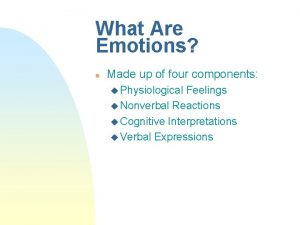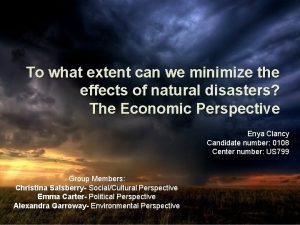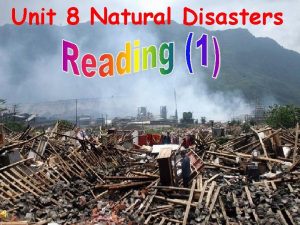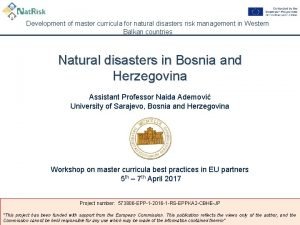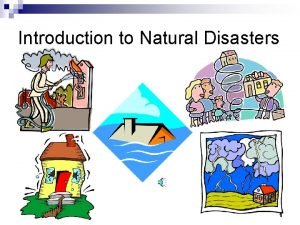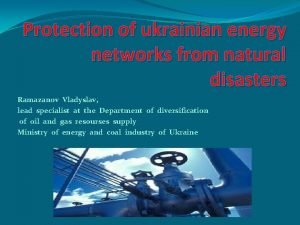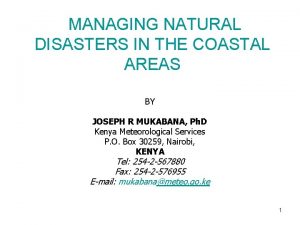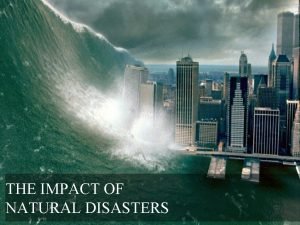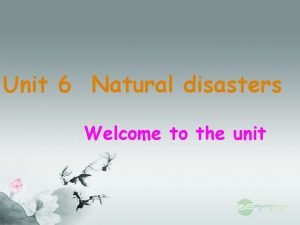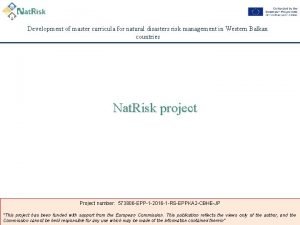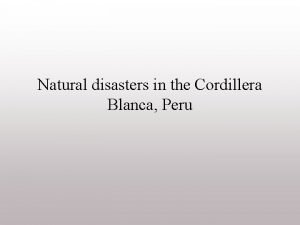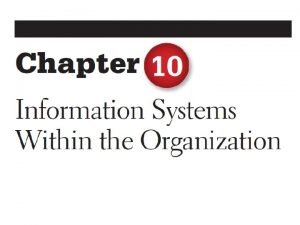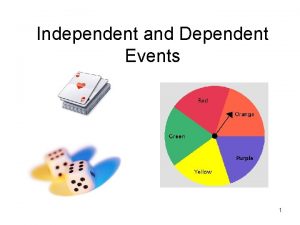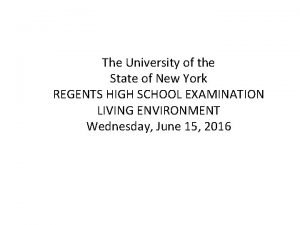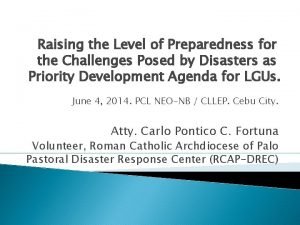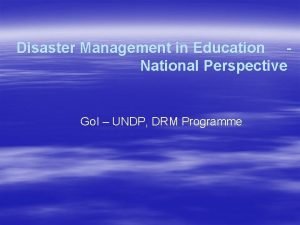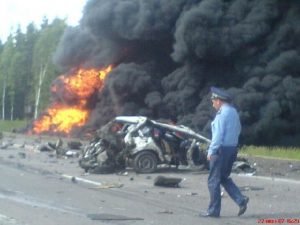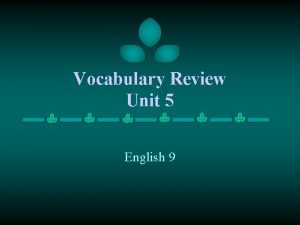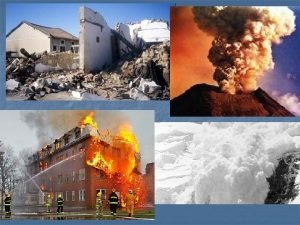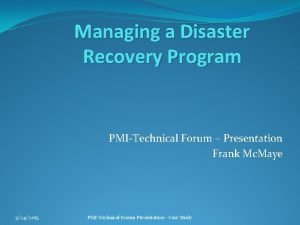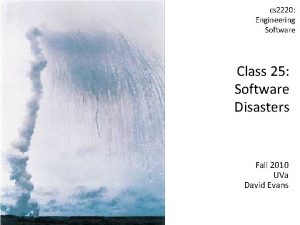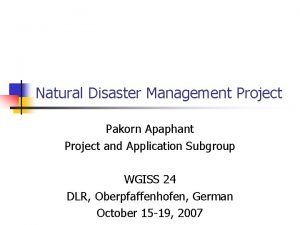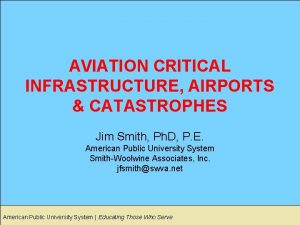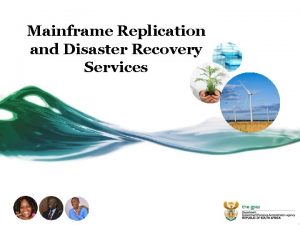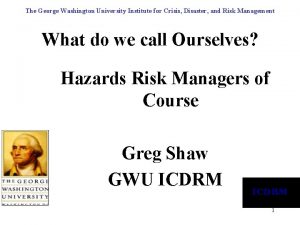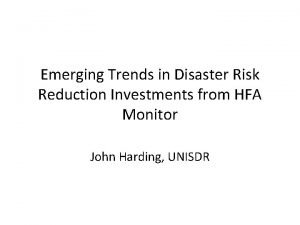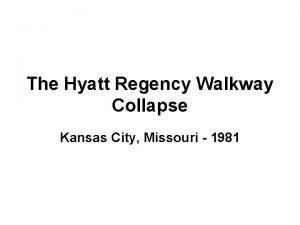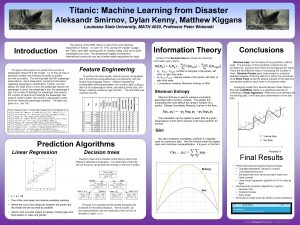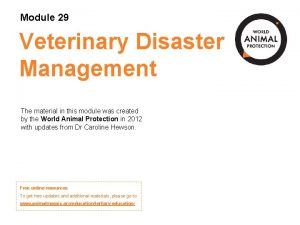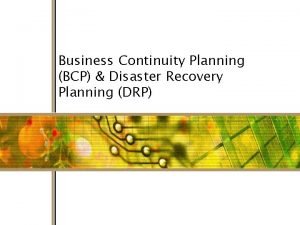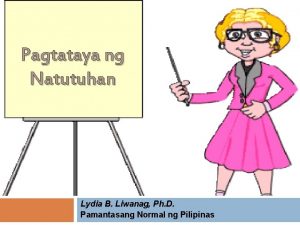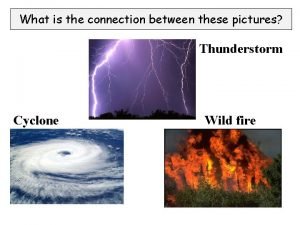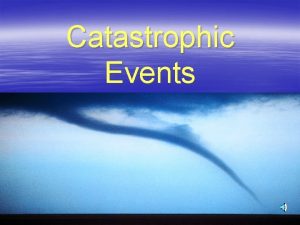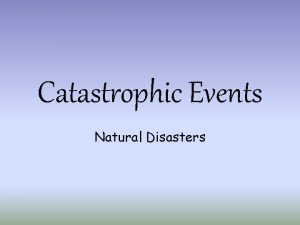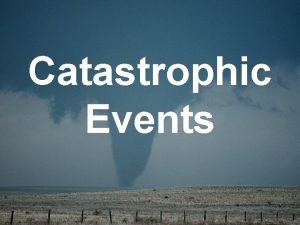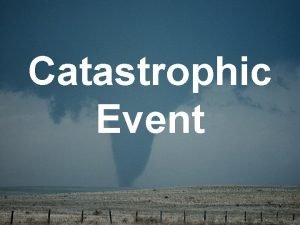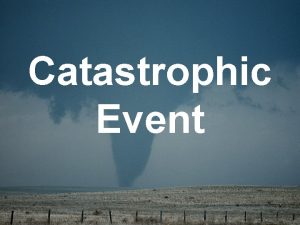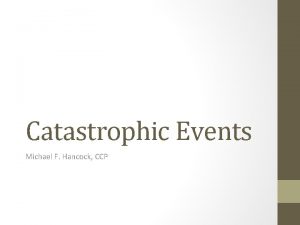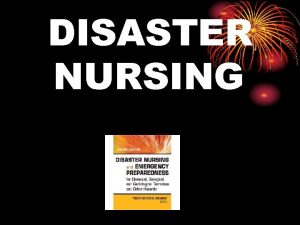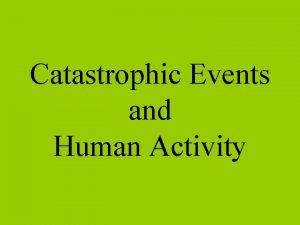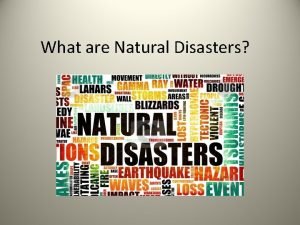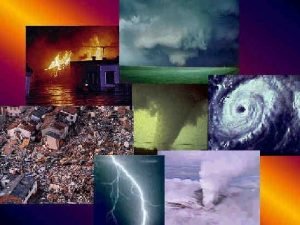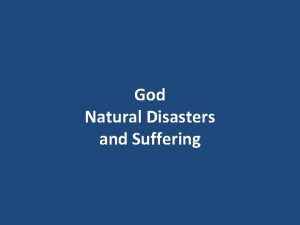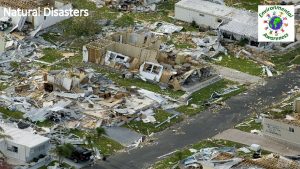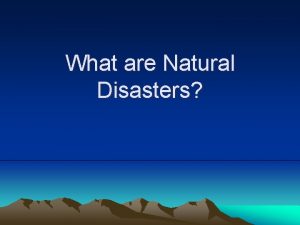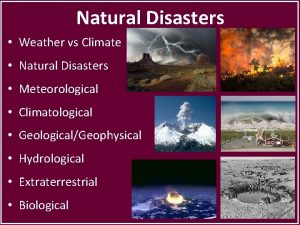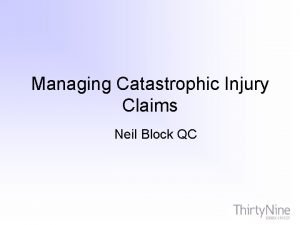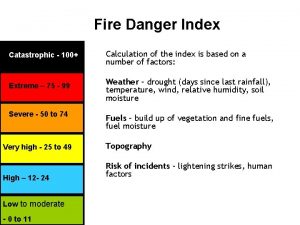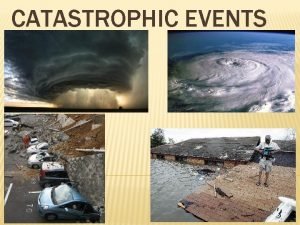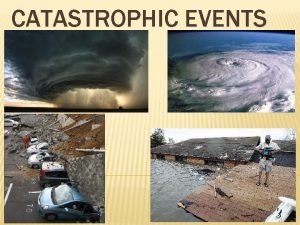Catastrophic Events Natural Disasters Natural Disaster Any event




























































- Slides: 60

Catastrophic Events Natural Disasters

Natural Disaster • Any event or force of nature that has catastrophic consequences, such as avalanche, earthquake, flood, forest fire, hurricane, lightning, tornado, tsunami and volcanic eruption.

Catastrophic Event • A sudden great disaster

Disasters • Catastrophic events are sudden, natural or man-made, situations where change & destruction occur. • All catastrophic events are the Earth’s way of maintaining equilibrium during change. • Since Earth’s dynamics are uncontrollable, accurate predictions are not always possible; studying these has an impact on scientific thought, society & the environment

Equilibrium • Equ = equal libra = a balance • A condition in which all acting influences are cancelled by others, resulting in a stable, balanced, or unchanging system. • A state of balance between any powers, forces or influences.

What you need from this Power. Point… • • • Name of natural disaster Main features of it How does it form? Where is it most likely to occur? What impact it could have on humans, wildlife, environment?

Wildfires • Lightning strikes cause one out of every five wildfires. • Wildfires can spread slowly from burning material along the forest floor or spread rapidly by wind causing it to jump along the tops of trees. • Drought conditions, wind, high temperatures and low humidity are conditions that help wildfires spread.

Wildfires • Wind has the biggest impact on a wildfire. • It gives the fire additional oxygen, further dries the fuel, and pushes the fire faster. • Wildfires can produce their own winds that can be ten times stronger than the winds around them.

Wildfires • A wildfire can destroy millions of acres of forest. • Watersheds can have all the vegetation burned off leaving the area prone to erosion. • Animals may become endangered due to habitat destruction. • The economic losses can impact humans if a fire sweeps through an inhabited area.

Fire What are the impacts on human and Earth? Cause? . . . Natural Manmade Careless

Hurricanes

Hurricanes • On average, ten tropical storms develop over the Atlantic Ocean, the Caribbean Sea, or the Gulf of Mexico each year. • About six of these develop into hurricanes • Many of these storms remain over the ocean.

Hurricanes • Hurricanes start out as tropical depressions, then develop into tropical storms (tropical cyclones). • When the winds reach a constant speed of 74 mph or more, it is upgraded to a hurricane. • Hurricane winds blow in a spiral around a calm center called an eye. • The eye can be up to 30 miles wide and the storm can be 400 miles in

Hurricanes • A single hurricane may last a week or more and travel the length of the East Coast. • A hurricane can have torrential rains, high winds, and a storm surge as it approaches land. • Most deaths from hurricanes are due to flooding. • Winds can drive ocean water up the mouth of rivers.

Hurricanes • Flooding can trigger mudslides or landslides. • Tornadoes can be spawned by hurricanes. • Economic costs and habitat loss is common.


Hurricane Impact on Earth…


Hurricane • Cause not entirely understood, but three events must happen for hurricanes to form – Continuing evaporationcondensation cycle of warm, humid ocean air – Patterns of wind converging winds at the surface and strong, uniform-speed winds at higher altitudes – A difference in air pressure ( pressure gradient) between the surface and high altitude

Drought • A drought is an unusually long period of dry weather that lasts long enough to cause water supply shortages. • One dry year is usually not long enough to produce a severe drought. • The severity of the drought depends upon the degree of moisture deficiency, the duration and the size of the affected area.

Drought • A dry spell that lasts into the second or third year can cause serious problems because the water supply is not being restored. • Surface water and subsurface water supplies below normal can affect humans, as well as plant growth.

Drought • Some areas can become desert when a drought occurs. • Other related problems include crop failure, livestock death, increased forest fires and water shortages. http: //staffwww. fullcoll. edu/tmorris/elements_of_ecology/images/drought_corn. jpg

Drought

Impact? ? ? Did we learn anything from the Dust Bowl Days?

Volcano • A volcano is a vent in the Earth which allows molten rock (magma) to escape to the surface. • When pressure from gases within the magma become too great, an eruption occurs. • Once the volcano erupts, the Earth moves to a state of equilibrium until pressure builds again.

Volcano • Eruptions can be slow and fairly quiet or violently explosive. • Hazards include searing hot, poisonous gases, lava, and pyroclastic flows, landslides, mudslides, earthquakes, increased fire hazard, explosions, rockslides, flash flooding and tsunamis.

Volcano • Volcanic ash is very fine glassy rock fragments. • It can affect breathing, contaminate water supplies, collapse roofs, disrupt machinery, and cause jet engines to fail while flying.

Volcano

Rearrange the land Make new land Kameni Islands…possible source for myth of Atlantis

Volcano

Volcano


Tornado • A tornado is a violently rotating column of air extending from a thunderstorm to the ground. • The most violent tornadoes have wind speeds of 250 mph or more. • Damage paths can be in excess of one mile wide and 50 miles long.

Tornado • Tornadoes in the winter and early spring are often associated with strong, frontal systems that form in the Central States and move east. • Thunderstorms develop in warm, moist air in ahead of eastward-moving cold fronts while the cold, dry air is behind it to the west. • These thunderstorms often produce large hail, strong winds and tornadoes.

Tornado • Along mountains, tornado producing thunderstorms can form as the air flows up the slope to higher land areas. • Tornadoes can form to the right and in front of the path of a hurricane as it comes on land. • The high winds from the tornado and the hail from the thunderstorms cause the most damage.

Tornado • Tornadoes can destroy buildings and vehicles, uproot trees, and scour the soil off the ground. • Tornadoes may appear transparent until the dirt and debris it picks up gives it color. • Two or more tornadoes may form at the same time.

Tornado • A waterspout is a weak tornado that forms over water. • If the waterspout moves over the land, it becomes a tornado. • Tornadoes are most likely to occur between 3 and 9 p. m. , but have been known to occur at all hours of the day or night.

Tornado • Human impact – Loss – Not fair – Others?

Tornado • Impact on Earth – Vegetation – etc

Tornado • Warm air gets trapped beneath a stable layer of cold, dry air; warm air rises into a cloud; becomes a vortex

Tsunamis • Tsunamis are ocean waves produced by earthquakes, volcanic eruptions, meteorite impact, or underwater landslides. • They are a series of waves that can travel between 450 -600 mph in the open ocean. • Ships in the open ocean would not feel the tsunamis because the wavelength would be hundreds of miles long and have amplitude of only a few feet.

Tsunamis • As the wave approaches the coast, its speed decreases and its amplitude increases. • From the starting point of the tsunamis, the waves travel outward in all directions. • As the wave approach the coast, the time between successive wave crests varies from 5 to 90 minutes.

Tsunamis • The first wave is usually not the largest or most destructive. • Often the waters will pull back before the wave arrives. • They are not v-shaped or rolling waves. • Tsunamis often come ashore as a rapidly rising turbulent surge of debris filled water.

Tsunamis • The waves can travel upstream in coastal estuaries, and rivers. • Tsunamis can occur during any season and at any time of day or night. • Areas of risk are less than 25 feet above sea level and within one mile of the shore. • Impact includes drowning, flooding, contamination of drinking water, loss of habitat or human homes, fires from broken gas lines, etc.

Tsunami

Tsunami • Human Impact – Loss of property – Loss of lifestyle – Emotional roller coaster

Tsunami After Before

Tsunami Formed by…….

Earthquake • An earthquake is the vibration of the Earth’s surface that occurs after a release of energy in the crust. • This release of energy can be caused by a volcanic eruption or movement of segments of the crust. • The crust may bend as the stress builds and exceeds the strength of the rock, breaks and snap into a new position.

Earthquake • This process releases pressures in the crust and the Earth’s crust reaches equilibrium again. • Seismic waves are created when the crust breaks. • The waves travel outward from the source of the earthquake at various speeds, depending on what material they move through.

Earthquake • Earthquakes impact rupture breaks in the ground, landslides, avalanches, fires, tsunamis, property damage, and loss of life.

Earthquake

Earthquake Cause

Flood • A flood is an overflowing of water onto the land that is normally dry. • A flood can be caused by intense or long term precipitation from thunderstorms, hurricane storm surges, or melting snow. • Floods can last from a few minutes to months. • The amount of flooding is controlled by the amount of water that builds up

Flood • Humans have altered the landscape in several ways • The most impact results from paving the ground for housing, roads, and parking lots. • Neither asphalt nor concrete is porous • All precipitation that fails becomes runoff.

Flood • Most of the world’s population lives near the coast or on flood plains. • Floods can cause loss of life, disease, property loss or damage, contamination of drinking water and destruction of crops and livestock.

Floods

Mud or Land Slides • Impact? – Inconvenient – Rearrange the land


Mud or Land Slides…Cause Building on locations where vegetation has been removed. Slope, soil type, rain amount and intensity all contribute
 What are some types of catastrophic events
What are some types of catastrophic events Catastrophic event
Catastrophic event Natural hazards vs natural disasters
Natural hazards vs natural disasters Catastrophic risk protection endorsement
Catastrophic risk protection endorsement Catastrophic epilepsy infancy
Catastrophic epilepsy infancy Facilitative emotions definition
Facilitative emotions definition Natural disasters conclusion for project
Natural disasters conclusion for project Taiwan earthquake
Taiwan earthquake Natural disasters
Natural disasters Define disaster
Define disaster Positive effects of earthquakes
Positive effects of earthquakes Conclusion on disaster management ppt
Conclusion on disaster management ppt Natural disasters listening comprehension
Natural disasters listening comprehension Natural disaster unit 9
Natural disaster unit 9 Helike greece
Helike greece Introduction of natural disasters
Introduction of natural disasters Social impact of disaster
Social impact of disaster Ancient natural disasters
Ancient natural disasters Three natural disasters
Three natural disasters Natural disasters
Natural disasters Natural disasters in the cordillera region
Natural disasters in the cordillera region Mutually exclusive vs non mutually exclusive
Mutually exclusive vs non mutually exclusive There isn't any chicken
There isn't any chicken Any to any connectivity
Any to any connectivity Any question atau any questions
Any question atau any questions Objective of transaction processing system
Objective of transaction processing system Town contaminated moscow
Town contaminated moscow Independent and dependent probability
Independent and dependent probability Whats a sentinel event
Whats a sentinel event Compound probability examples
Compound probability examples Events management team structure
Events management team structure Event background
Event background Independent event vs dependent event
Independent event vs dependent event Farmers may someday clone their best milk producing
Farmers may someday clone their best milk producing Conclusion on natural disaster
Conclusion on natural disaster Man-made disasters introduction
Man-made disasters introduction Crash that is speeding
Crash that is speeding English language paper 2 rail disasters mark scheme
English language paper 2 rail disasters mark scheme Most historians agree that military disasters
Most historians agree that military disasters Accidents & disasters
Accidents & disasters Chapter 8 emergency care first aid and disasters
Chapter 8 emergency care first aid and disasters Types of disasters
Types of disasters What is a disaster
What is a disaster Software engineering disasters
Software engineering disasters What are disasters
What are disasters Conclusion of disaster management
Conclusion of disaster management Natural capital
Natural capital Seveso disaster
Seveso disaster Mainframe disaster recovery services
Mainframe disaster recovery services Institute for crisis disaster and risk management
Institute for crisis disaster and risk management Principles of incident response and disaster recovery
Principles of incident response and disaster recovery Chernobyl nuclear disaster webquest
Chernobyl nuclear disaster webquest Emerging trends in disaster mitigation
Emerging trends in disaster mitigation Kansas city hotel disaster
Kansas city hotel disaster Titanic machine learning from disaster
Titanic machine learning from disaster Veterinary disaster management
Veterinary disaster management Civil defence disaster management
Civil defence disaster management Contoh business impact analysis
Contoh business impact analysis Mga halimbawa ng rubrics sa filipino
Mga halimbawa ng rubrics sa filipino Disaster definition
Disaster definition Hazard vs disaster
Hazard vs disaster





